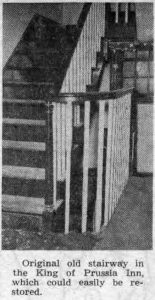 Elsie Lathrop, author of “Early American Inns and Taverns,” to which reference has been made from time to time in this column, found so many such hostelries in her travels through Pennsylvania that she devoted two chapters to our state alone. In view of the current interest in the King of Prussia Inn, we are going to give a full description of the inn as it looked to Miss Lathrop over 30 years ago.
Elsie Lathrop, author of “Early American Inns and Taverns,” to which reference has been made from time to time in this column, found so many such hostelries in her travels through Pennsylvania that she devoted two chapters to our state alone. In view of the current interest in the King of Prussia Inn, we are going to give a full description of the inn as it looked to Miss Lathrop over 30 years ago.
“Built in 1709 the old house is as staunch as ever. The original two rooms on the right as one enters, have old fireplaces across adjoining corners, as have the rooms above, now used as private dining rooms. On the left downstairs, the rear room is the old kitchen, with an enormous fireplace in which two persons may sit comfortably in chairs. The old crane is still in place, as is the old oven, and up in the wall of the chimney is a small niche for keeping food warm. In front of the kitchen is the old bar. From the kitchen, a steep, narrow flight of stairs testifies to its age, and one may admire massive old beams and some of the old doors and hinges. The original stables and springhouse are still standing.
“The Inn was given its name by the builder, a native of Prussia, only a few years after the Elector of Brandenburg had made the duchy of Prussia into a kingdom and had established himself as King Frederick of Prussia.”
The date, 1769, is sometimes given the inn, as a later building date than that of 1709. However, it would seem more probable that the latter was a remodelling date for the structure. But whether 1769 was a building or a remodelling date, the work was done at that time by one Daniel Thompson, according to records in possession of the King of Prussia Historical Society. According to these same records, Thompson was a “fighting Quaker” who was active for eight years in the Revolutionary War.
The inn has definitely housed some of the most outstanding figures from the pages of American history. During the yellow fever epidemic in Philadelphia, In 1793, Jefferson, Madison and Monroe stayed there. George Washington is said to have frequented it during the war. It is also said that not only Washington, but many other renowned men of the Revolutionary War period, attended Masonic meetings held there. Besides the historical background, there is the close proximity of the wide-spreading “Washington Oak,” which was growing when William Penn came to Pennsylvania.
The building itself is made of local stone, probably quarried from a bed on the present Croton road. This stone is now covered with plaster. As to the interior, a small brochure issued two years ago by a group of individuals interested in the preservation of the old landmark, states that “even successive alterations have not marred the charm given it by certain quaint proportions and from the large old fireplaces and other sources.”
If recommendations of the restoration committee as outlined in last week’s column were to be adopted, much of the cost of the work entailed could be cut down by volunteer work, to be given the project by skilled craftsmen in the King of Prussia neighborhood. Following the recommendation of this committee, this statement was issued:
“Since this is a community project, the restoration committee feels that it is only fair to permit those who are interested in contributing their skills to do so. Obviously there will be a close supervision of such efforts and there will be a final inspection by local officials, as well as the Historical Society Restoration Committee, before the building is used. The restoration committee agrees to use the plans drawn up by Mr. John T. Brugger, Jr., architect.”
The committee further points out that with the labor contributed, the cost of restoration could be cut to a minimum. Fortunately, there are many in the community who are skilled in cabinet making, electrical work, plumbing, carpentry, wall papering, painting or even just “pushing a broom.” And as a concluding argument for this means of restoration, the committee states that “a building which is restored through the efforts of those who would use it has a much more secure future than one for which money has been solicited and unwillingly given.”
Thus the stage is set to save for posterity one of the most historic old buildings in our neighborhood. Plans are made, funds are promised, skilled labor is offered. All that is needed is an entirely clear title to the property which, as all concerned continue to hope, may be forthcoming in the not too distant future. For those of our readers who may be interested in helping to clear up the situation, the names of those who are incorporators of the new King of Prussia Historical Society are again given. Information may be obtained from Dr. Robert A. May, Mrs. Lucressa Morrison and John R. Arscott, all of King of Prussia; Mrs. Mary Townsend and Dr. Deane Webber, of Colonial Village, Wayne.
